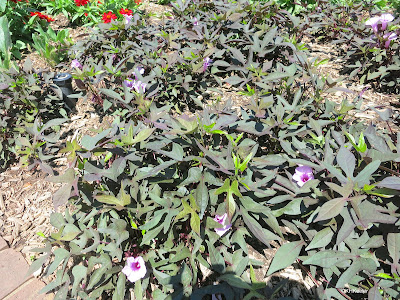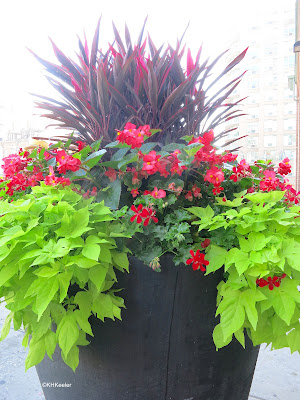Sweet potatoes are morning glories, or morning glories are sweet potatoes. That's because sweet potatoes are Ipomoea batatas, in the genus Ipomoea with all the morning glories. If you've grown sweet potatoes, you will have seen the tubular blue flower, very like weedy morning glories such as Ipomoea hederacea and Ipomoea purpurea.
 |
| sweet potatoes, Ipomoea batatas |
Sweet potato is a perennial, forming starchy tubers, the potatoes, underground. The genus Ipomoea, morning glories, plant family Convolvulaceae, includes about 600 species. A few other species have tubers like sweet potatoes and mainly those are edible, though some become too woody to eat in a year or two. Sweet potato is native to the American tropics and has been cultivated for at least 5,000 years from Peru to southern Mexico. Sweet potatoes from archaeological sites in Peru were dated to 10,000-12,000 years before present; its been a food for a long time.
 |
| sweet potatoes, Ipomoea batatas |
So popular were sweet potatoes that they went around the world almost immediately after 1492, becoming part of the culture in places from Africa to the Hawaii. That dispersal obscured the fact that sweet potatoes were already in the Pacific. Careful recent studies have documented that sweet potatoes reached Polynesia by 1100 - 1200 CE, well before Columbus, documenting contact between the Pacific Islands and South America.
 |
Having been all over the world for more than 1000 years, sweet potatoes are very variable. They are polyploid with 90 chromosomes, six times the base number of the genus Ipomoea, and not very fertile but over hundreds of years, different people selected for different characteristics, so the "meat" ranges from white to deep orange to red, very starchy to very sweet, in skins from pale to red, growing on plants with heart shaped or nearly round leaves to ones that are almost three-lobed, the leaves from bright green to almost black. (search on "sweet potato diversity, images"). If you don't like sweet potatoes, you might taste some that look really different; flavors and textures vary too.
 |
| sweet potatoes, Ipomoea batatas |
Sweet potatoes from the Caribbean were welcomed in the U.S. South because they rememble yams, genus Dioscorea, a staple starchy tuber of Africa. Yams (Dioscorea, and there are many species) superfically resemble sweet potatoes. In the U.S., sweet potatoes are often called yams. "True yams" are rarely for sale in the U.S., almost all "yams" are really sweet potatoes (genus Ipomoea). Very confusing.
 |
| crop of sweet potatoes |
Sweet potatoes need a long growing season and only survive light frosts, so are a crop in the southern U.S. They are sold as annual vegetables in the North and some, if started indoors, grow fast enough to produce tubers fairly far north. Today, some are grown as ornamentals for their attractive foliage.
 |
| sweet potato leaves as ornamentals |
The internet promotes eating sweet potato leaves. Apparently they are safe to eat, although can upset the stomach due to the presence of oxalate compounds; eat small quantities initially. However, do not generalize that because sweet potatoes look like other morning glories, that morning glory leaves are edible. Sweet potatoes and their close relatives have been domisticated for millennia. Ancestral in morning glories formed a relationship with the Claviceps fungi, which put ergoline alkaloids--LSD and similar chemicals--into morning glory tissues. They are especially concentrated in the seeds, in lesser amounts in the leaves, and virtually absent in flowers (the flowers are only open for one morning). LSD produces significant hallucinations but also nausea and diarrhea, sleeplessness, loss of appetite, tremors and more. These have been bred out of sweet potatoes, but are present in many other morning glory species, some of which look remarkably like "wild sweet potatoes." If you are going to eat sweet potato leaves, get them from a reliable source.
 |
This is a major food plant, the tubers an important healthy vegetable, all around the world. With pretty flowers and attractive leaves!
Comments and corrections welcome.
References
Bohac, J. R., P. D. Dukes, and D. F. Austin. 1995. Sweet Potato, Ipomoea batatas (Convolvulaceae). pp. 57-62 IN J. Smartt and N. H. Simoonds. Evolution of Crop Plants. Longman Science and Technology, London.
Eserman, L.A., G. P. Tiley, R. L. Jarret, J. H. Leebens-Mack and R. E. Miller. 2014. Phylogenetics and diversification of morning glories (tribe Ipomoeeae, Convolvulaceae) based on whole plastome sequences. American Journal of Botany 101 (1): 92-103.
Roullier, C., L. Benoit, D. B. McKey, and V. Lebot. 2013. Historical collections reveal patterns of diffusion of sweet potato in Oceania obscured by modern plant movements and recombination. PNAS (Proceedings of the National Academy of Sciences, U.S.A.) 110 (6): 2205-2210.
Yes right information! I can't see this type of blog!
ReplyDeletePay Someone To Take My Online Course For Me